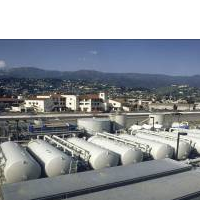Santa Barbara Reanimates Desalination Plant Closed for 23 Years
 The Charles E. Meyer Desalination Plant
The Charles E. Meyer Desalination Plant
Desalination is one of the most expensive, energy-intensive and environmentally harmful water supply options available, but that didn’t stop the Santa Barbara City Council from unanimously voting to restart a little-used plant that was mothballed in 1992.
The decision was made just hours after a storm dropped an inch of rain on the city, giving everyone pause. The Charles E. Meyer Desalination Plant was built during a fierce drought between 1986 and 1991 and then put in standby mode after just four months when the rains returned.
But the $34-million plant, which was paid off long ago, has never been far from resident thoughts. On Tuesday, the council agreed to spend another $55 million to bring the plant back online by 2016. The plant could provide around 30% of the city’s water needs.
Operation of the plant will add $10-$20 to utility bills each month, but council members expressed a willingness to pay that even if giant El Niño storm systems bring heavy, sustained rain to the area, as many climatologists cautiously predict. “This drought will end one day,” Mayor Helene Schneider said. “But there will be another drought another day.”
The Santa Barbara Independent said all the council members were conflicted over the plant, some citing environmental issues. Just about nobody denies those problems are substantial and can only be mitigated at best, not eliminated. But like a lot of environmental concerns in the Age of Drought, they tend to be obscured or overwhelmed by other considerations.
On average, desalination plants take in two gallons of seawater for every gallon of fresh water produced. The environmental impact varies depending on the type of system used, but, in general, millions of sea creatures are sucked into saltwater intake valves and chemically-infused concentrated brine is returned to the ocean. The plants use an ungodly amount of electricity and pump out a lot of greenhouse gases.
Some of the obvious ill effects of desalination are known, but much is unknown because, according to a 2011 study by the Golden Gate University Environmental Law Journal, there has been no “comprehensive monitoring and evaluation of the surrounding ecosystems.”
Now California will get a chance to flesh out the body of knowledge. Communities in the state have toyed with desalination for decades, and at one time more than 21 active proposals to build plants were in the pipeline. About 15 or so are still kicking around. But few have been built until now.
A $1-bllion plant in Carlsbad, the largest plant in the Western Hemisphere, is due open in November and another Southern California plant in Huntington Beach is close to gaining approval. The Carlsbad plant would provide around 50 million gallons of water a day to San Diego County, satisfying about one-tenth of its needs.
–Ken Broder
To Learn More:
Desalination Plant to Be Reactivated (by Sarah McCarthy, Santa Barbara News-Press)
Council Pulls $55 Million Trigger to Restart Desal Plant (by Nick Welsh, Santa Barbara Independent)
Santa Barbara to Spend $55 Million on Desalination Plant as Drought "Last Resort" (by Matt Hamilton, Los Angeles Times)
Santa Barbara’s Desalination Plant Is No Quick Fix for Drought Conditions (by Giana Magnoli, Noozhawk)
California Drought Renews Thirst for Desalination Plants (by Steve Gorman, Reuters)
Santa Barbara Desalination Plant May Emerge from Mothballs (by Darryl Fears, Washington Post)
Coastal Commission Blocks Flawed Desalination Plant Similar to One Being Built Nearby (by Ken Broder, AllGov California)
Key Issues in Seawater Desalination in California (by Heather Cooley, Newsha Ajami and Matthew Heberger, Pacific Institute) (pdf)
- Top Stories
- Controversies
- Where is the Money Going?
- California and the Nation
- Appointments and Resignations
- Unusual News
- Latest News
- California Forbids U.S. Immigration Agents from Pretending to be Police
- California Lawmakers Urged to Strip “Self-Dealing” Tax Board of Its Duties
- Big Oil’s Grip on California
- Santa Cruz Police See Homeland Security Betrayal in Use of Gang Roundup as Cover for Immigration Raid
- Oil Companies Face Deadline to Stop Polluting California Groundwater





